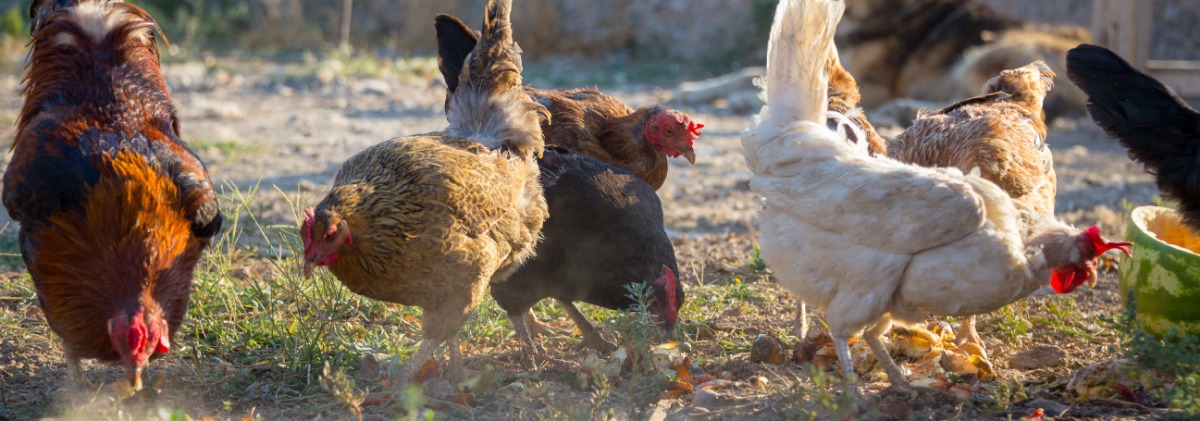Bird Flu and the Backyard Poultry Flock

Photo: Adobe Stock
Highly Pathogenic Avian Influenza (HPAI), often referred to as bird flu, is a virus that results in high mortality rates in domestic poultry and some wild birds. While low pathogenic variants are more common, lead to less severe disease or no clinical disease and are easily managed, the current highly pathogenic strain of bird flu has resulted in the deaths of tens of millions of birds since 2022. Additionally, crossover infections in other species have been confirmed, with exposure to infected poultry and poultry products being the primary vector. HPAI, however, is not a food safety issue. Handling, cooking and consuming poultry and egg products remain safe.
Meat-eating and scavenging mammals such as skunks, foxes, bobcats, rodents and domestic cats have tested positive for bird flu. Hobby farm animals and pets may also be infected. In spring 2024, the first cases in dairy cattle were confirmed; the initial infections were the result of exposure to infected wild birds. Human cases have been few and primarily result in inflamed eyes and mild upper respiratory symptoms, but severe complications with any influenza virus are possible. Such HPAI cases mainly involve dairy and poultry workers, but also enthusiasts with backyard flocks. According to the Centers for Disease Control, of the 70 confirmed human cases in the U.S. to date, only one has resulted in death, and there were contributing factors related to age and underlying health conditions. This is a reminder that immunocompromised, young, and older individuals should practice extra caution in poultry keeping; youth should be well supervised.
What does that mean for the average person not engaged in commercial poultry and egg production? The biggest impact is likely in the marketplace, where HPAI is a variable in the ongoing high price of eggs. Backyard flocks can be susceptible, which also poses risks to poultry keepers. Finally, anyone who spends time outdoors could stumble upon a possibly infected dead bird or harvest a potentially infected game bird. With a few precautions, though, the risk to humans is low. Whether you keep poultry, manage bird houses, or happen upon a dead bird, avoiding infectious materials and practicing basic hygiene can keep you safe.
Poultry keepers should contain their birds and do all things possible to exclude wild birds from coops and other habitats. Make sure enclosures are well built and without gaps that would allow intermingling of wild birds with domestic ones. Commercial growers and hobbyists alike should not be sharing undisinfected tools and equipment, nor visiting each other’s production areas or habitats. When cleaning coops or yards and completing poultry-related chores, it is advisable to wear gloves, dedicated clothing and footwear, and a mask to reduce direct contact with, or inhalation of, infected materials (manure, litter, feathers, dust and dander). As always, wash your hands immediately and well prior to and after chores. Handling of any dead birds should be done with similar caution, with the addition of double bagging before disposal. While commercial poultry response usually involves composting of dead birds at a large scale, home composting systems are not appropriate for disposal.
There are some bleak realities to HPAI infections and response. Firstly, the disease is devastating, with very high mortality rates for infected birds. Secondly, control of the disease is often achieved by depopulating infected farms and small flocks. This is a gently worded way of saying that all infected and directly exposed birds are euthanized.
Regulations have changed throughout this avian influenza outbreak. Currently, the size of the flock and use determine the outcome. An owner may not be required to euthanize if they don’t sell poultry or poultry products, but they do so because of concern about disease severity or risk to people and other animals. Owners whose birds are depopulated are eligible to receive indemnity to offset financial loss from depopulation.
Response involves oversight by an animal health authority, such as the state veterinarian’s office or a USDA veterinary office. Given this sad reality, it is difficult to report suspected infections to animal health authorities, but this duty is imperative to safeguard human health, promote animal welfare, and support the agri-food economy. State law also requires reporting of any potentially highly contagious or infectious disease. Depopulation is followed by intense cleaning, disinfection, and a fallow period or pause in production for previously infected facilities.
Regarding suspected infections and dead birds, please refer to liv.mt.gov/Animal-Health/Avian-Influenza-2022, where there is guidance on surveillance, quarantine, handling and disposal; you may be requested to submit the animal to the state diagnostic lab. While not every suspect bird needs to be submitted, reporting and testing are imperative to understand the severity and distribution of this ongoing outbreak.
University of Georgia Extension, in support of the state’s significant poultry industry and enthusiast population, also provides this website for public information and guidance (University of Georgia Extension response contacts are for Georgia only).

Photo: Adobe Stock
WHAT TO WATCH FOR IN A BACKYARD FLOCK:
|
Tommy Bass is an MSU Extension Associate Specialist
for livestock sustainability working at the nexus of
environmental stewardship, livestock and meat in local/
regional food systems, and agricultural emergency
management.
